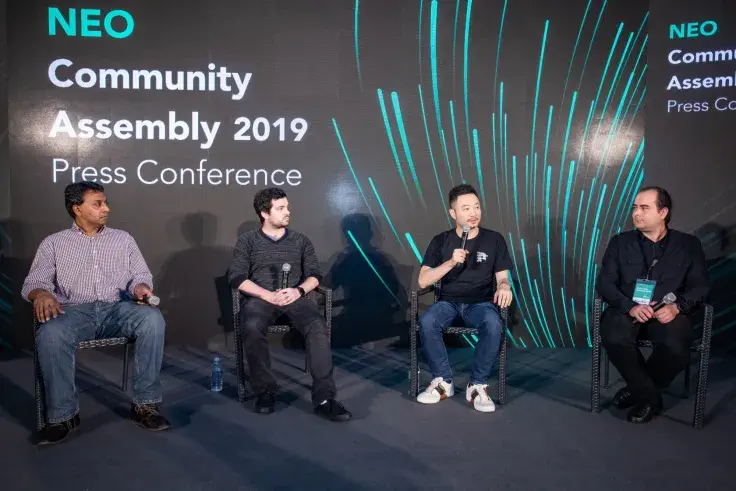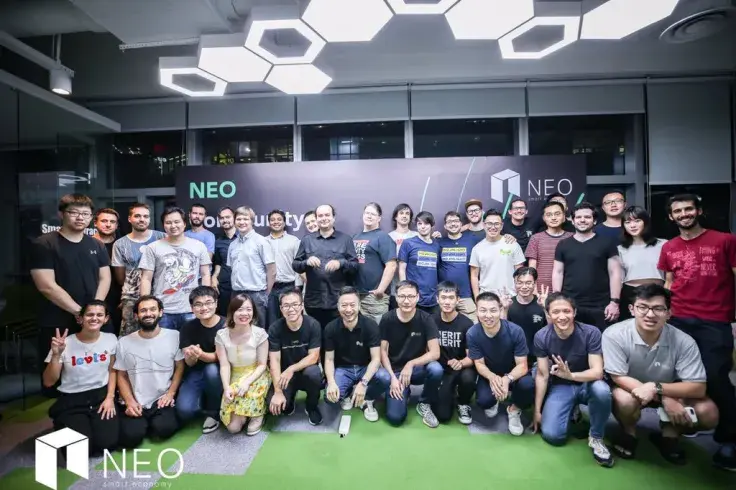
When it comes to blockchain projects, we usually think of something that has a digital basis and some kind of a futuristic concept to it. But the main idea of every project is to make it a real part of people’s everyday life. NEO is an open network whose vision is to realise a “smart economy” by using the blockchain technology and smart contracts to manage digitized assets. Today, we’re having NEO’s Head of NGD Seattle, John deVadoss, on board. We had a chance to ask him about the NEO’s nearest plans, his Microsoft background, and favourite cryptocurrencies (except NEO).
U.Today: Hey John, thank you for joining us. First of all, I’d like to ask you some common questions. Why do we need Neo 3.0? What makes it different from the existing Neo blockchain network and from other projects based on smart contracts?
John deVadoss: The way I see it is this: we’ve had the wave of coins, then we’ve had the wave of chains, and now the market is ready for platforms. This is the feedback we get from developers, customers, and partners. So, what do I mean by a platform? A comprehensive and cohesive stack that has the VM, the chain, but also, for instance, NeoID in terms of identity, storage as inNeoFS, support of oracles, support for the developer lifecycle, support for tooling and more. Our singular vision is to make smart economy real, to digitize any and all assets. So, if you want to digitize assets, you need a full-stack. That’s really what the genesis of the strategy and the launch of NEO 3.0 are about — a comprehensive stack, a platform that goes well beyond the chain.
What I see is they’re looking for this ideal dApp, the sort of mythical, elusive, “unicorn” dApp. They say: “Oh yeah, once we get the dApp we will get adoption.” But that’s not how it works. There’s no mythical dApp. They are completely wrong. The way adoption works is you enable millions of developers, and when you do so, a thousand flowers will bloom, and among those flowers, there will be many dApps that will drive adoption and more importantly usage.
Advertisement
U.Today: You have extensive experience of working at Microsoft. How did it help you with NEO? Recently, NEO joined the Microsoft-created .NET Foundation as a member (the first blockchain organization to do so). What does this achievement mean for NEO?
John deVadoss: I’ve spent a long time (probably too long *laughs*) at Microsoft. I spent most of my time there, building platforms for developers, I led the architecture strategy for version 1 and version 2 of the .NET platform. I also spent time working on the tooling and libraries for developers for the .NET platform. So, I think of myself as a platform guy. I would say much of my time at Microsoft was very relevant and probably very timely for me as well, as we focus on developers for NEO.
You know, there are many chains out there, right? What I see is they’re looking for this ideal dApp, the sort of mythical, elusive, “unicorn” dApp. They say: “Oh yeah, once we get the dApp we will get adoption.” But that’s not how it works. There’s no mythical dApp. They are completely wrong. The way adoption works is you enable millions of developers, and when you do so, a thousand flowers will bloom, and among those flowers, there will be many dApps that will drive adoption and more importantly usage. So what I learned from the successful work in the .NET platform as well as Windows Azure, is that you put developers first, you give them the best tools to develop and to distribute their applications, and magic will happen. That’s what we’re doing at this point for NEO.

NEO by chainnews.com
U.Today: In one of his interviews, Da Hongfei said that one of his goals is to make NEO the most developer-friendly public chain. Do you think you can succeed with that?
John deVadoss: Absolutely! In fact, the very genesis of building NEO from the beginning is as a polyglot platform. So, unlike, for example, Ethereum which went down the path of a special-purpose language in Solidity, we said: “We will go to where the developers are. If developers use C#, or Java, or JavaScript, or Python, or Go, we go to them and serve them." In NGD Seattle where we’re building the tooling for .NET and Visual Studio, we say: “If we ask developers to come to us, that’s not so easy, but if we go right to where they are, it’s much easier, right?”. So yes, absolutely, I very strongly believe that you will see us in the next 12-18 months making even stronger strides to being the most developer-friendly platform. It is the only way to be successful. As a platform what you need is developers. And we have the experience, we have the people, we are hiring from Microsoft and Amazon and others, and we have done this before, so we understand the challenges and we are very clear about the goals. This is the only way to build a successful platform; I’m very enthusiastic and I’m very committed to making it happen.
“If we ask developers to come to us, that’s not so easy, but if we go right to where they are, it’s much easier, right?”
U.Today: Neo 3.0 TestNet has been launched. Have you got any feedback from developers?
John deVadoss: I’m glad you asked this question! Yes, so, there are two things: first, we have gotten a lot of feedback from developers about the features. The reason to launch the TestNet and to announce the roadmap of features was to get early and on-going feedback. In September we had the first NEO Global Community Assembly in Shanghai and we had about 60-70 developers from all over the world get together to share, to discuss, so the feedback has been very strong.
U.Today: Will you need a hard fork to upgrade to NEO 3.0?
John deVadoss: It doesn’t have to be a fork. People immediately think that the hard fork is the option. It is but one option. But what we are working on and looking at very carefully is to port the newer features back to NEO 2.0 as we build out NEO 3.0 and at some point pause the block generation for NEO 2.0 to take a snapshot and then to create a new Genesis Block for NEO 3.0. So it would not be a fork, it would basically be a managed shift to NEO 3.0. So in this way, you won’t necessarily need to have multiple chains as in a forking scenario and rather you have very clean migration from NEO 2.0 to NEO 3.0. As I said, there are many detailed options, and we will obviously pursue the option that has the most support from the developer community worldwide.
U.Today: When do you plan to launch it?
John deVadoss: We’ll launch NEO 3.0 next year, certainly in the first half.

Roadmap of NEO 3.0 by chainnews.com
U.Today: Do you believe that one day NEO will supplant Ethereum? When do you think it can happen?
John deVadoss: This is a really good question! Funny enough, last week I was visiting the Ethereum Devcon. First of all, I don’t think we have to see it as about a single chain being the winner. Based on my platform work at Microsoft, I know and strongly believe there will be multiple chains; multiple platforms that will be successful. There are enough opportunities, enough potential for multiple platforms. I believe that Ethereum has its own problems. I was there for 5 days in Osaka and I was looking at, for example, challenges in moving to proof-of-stake, the challenges in sharding because, for example, when they do the sharding support they potentially break every single existing smart contract. So I think Ethereum has a lot of issues of their own to address in the next two years or so. They might have some significant forking challenges as well. But we don’t see it as a competition with Ethereum. Our vision is very singular focused on enabling the smart economy. We are very focused on making smart economy real. We believe that we will be the number one platform for the smart economy.
U.Today: To be honest, I’m not a tech-minded person, so can you explain to me and our readers what the decoupling of NeoVM from the NEO blockchain means to the NEO community and blockchain developers in general?
John deVadoss: That’s a really good question! I don’t think it’s fair to say that you’re not technical-minded because the fact that you’re asking me that question actually proves that you’re very savvy about the technology. First of all, from designing a platform architecture it’s always good to have loose coupling as a principle; loose coupling of the key components. In this case, not to have the VM and the chain be very tightly integrated.
Second, having a separate VM makes it that much easier for developers to debug, to attach the VM to any IDE, and to debug smart contracts. As you probably know, debugging smart contacts today on any platform is very difficult, and we’re making some significant advancements in making debugging easier.
We fully understand that this shift to decentralization is real. We’re totally committed in terms of decentralization. I don’t see it as having like tens of thousands of consensus nodes, but certainly I see it as having much more, in the mid-term.
Number three, as a platform we also would like to make sure that what we build is used by other developers across the global community. So, when we decouple the VM from the chain, it makes it so much easier and certainly so much more possible for other developers to use the VM. There are some significant advantages. I would like to see more developers across the globe using the VM stand-alone. And we will see it happen as we launch NEO 3.0l.
U.Today: Will NEO be decentralized one day? When do you think it can be possible?
John deVadoss: I think what you mean by that is the number of the consensus nodes. So, for us, in the next 6 to 8 months, the focus will be on NEO 3.0. This is a critical priority for us. So you’re probably not going to see much in terms of any other priority in the very short term. However, beyond the launch of NEO 3.0, absolutely yes. The reason why we’ve had a smaller number of nodes is the trade-off. The trade-off in terms of opening it up indiscriminately vs. the number of nodes which is much more manageable to foster innovation and growth. We fully understand that this shift to decentralization is real. We’re totally committed in terms of decentralization. I don’t see it as having like tens of thousands of consensus nodes, but certainly I see it as having much more, in the mid-term.
As soon as we get a successful clean migration to NEO 3.0 done, the next big priority is going to be in these areas.
U.Today: In fact, NEO should become a kind of a “bridge” between real and virtual economies that operates on the basis of smart contracts. Do you pursue such a goal as the conclusion of contracts with the governments?
John deVadoss: This is a fantastic question, you’re absolutely correct. The way we will see this shift happened is via hybrid models, hybrid dApps. For us, things like NEO ID, NeoFS, the Oracle are all about enabling this bridge. As for myself, I feel like I have one foot in the old world and one foot in the decentralized world. So, everything we can do to enable this bridge is absolutely critical for developers.
The second, in terms of who we work with. We work with a lot of agencies from the private sector, the public sector, etc. and we are keeping it very open. We don’t necessarily see it as only the government or public sector agencies or something like that. We see it as anybody who is willing and shows the commitment and focus to work with us. In fact, we are doing even more work in the Americas, and also in Europe, in addition to Asia in terms of supporting policy and regulation to create a level playing field, and we continue to play our part in providing feedback. And like you said, this bridge between the old and the new is critically important for the public sector agencies and services. Agencies similar to the UN and UNHCR, you’re right, we work with many of them. But it’s not just about government, it can be private, public all the way in between as well.

NEO by @NEOnewstoday
U.Today: What cryptocurrencies, maybe not so popular projects, would you single out on the market? What are your favorites and why? Not counting Neo, of course :)
John deVadoss: That’s a tough question *laughing*. What I like are coins that have a very clear purpose. So certainly I'm a very big fan of stablecoins. I think that time is right for stablecoins. But we don’t know which ones will be successful. I mean will Libra happen or not? We don’t quite know. But certainly I strongly believe that the successful stablecoins will be based on a basket, a basket of multiple fiats, commodities like oil or gas and so on. I’m a very big fan of that shift, I think the time has come, people across the world are ready. There are questions about fiat stability, as we’ve seen in many countries, so I am a big fan of stablecoins that have a balanced basket of both fiat and other commodities etc.
U.Today: You’ve mentioned Libra. What are your thoughts on it?
John deVadoss: You know, in English they say the phrase “canary in the coal mine” which means that this is a sign of things to come. For me, it’s less about the Libra implementation but the Libra announcement. It tells me that the market is ready, people are ready, policy groups are ready. But I have strong reservations about Libra, because I spent some time looking at their architecture, it’s not very innovative, they have not done much to give back to the ecosystem, while they’ve taken a lot from the community, and maybe it’s the Facebook culture. They are not looking at it as a community effort, they see it as a purely commercial initiative, what I called a walled garden. That’s not a good thing, to my mind. That carries risk in terms of regulation and policy. And as we have seen in the last few months, people like PayPal and Visa are dropping out, that’s not a good sign. But I see the potential. Maybe it’s not Facebook, but there will be Libra-like stablecoins. I’m certain.
But I have strong reservations about Libra, because I spent some time looking at their architecture, it’s not very innovative, they have not done much to give back to the ecosystem, while they’ve taken a lot from the community, and maybe it’s the Facebook culture.
Only time will tell if there’s any chance for Libra or other stablecoins to get a global recognition, but we can see that more and more brilliant minds are getting involved in blockchain developments day by day with projects, and we are slowly but surely taking this mainstream with the goal of making this a better world for all of us.
 Arman Shirinyan
Arman Shirinyan Alex Dovbnya
Alex Dovbnya Yuri Molchan
Yuri Molchan Godfrey Benjamin
Godfrey Benjamin Gamza Khanzadaev
Gamza Khanzadaev